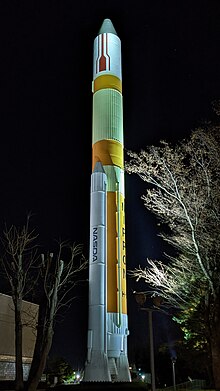
Back H-II (ракета-носьбіт) Byelorussian H-II (família de coets) Catalan H-II German H-II Spanish H-II Finnish H-II French H-II Galician H-II (סדרת משגרים) HE H-II Croatian H-II ID
 H-II rocket at Tsukuba science museum & planetarium | |
| Function | Medium-lift launch vehicle |
|---|---|
| Manufacturer |
|
| Country of origin | Japan |
| Size | |
| Height | 49 m (161 ft) |
| Diameter | 4 m (13 ft) |
| Mass | 260,000 kg (570,000 lb) |
| Stages | 2 |
| Capacity | |
| Payload to LEO | |
| Mass | 10,060 kg (22,180 lb) |
| Payload to GTO | |
| Mass | 3,930 kg (8,660 lb) |
| Associated rockets | |
| Family | H-II family |
| Based on | H-I |
| Derivative work | H-IIA, H-IIB |
| Comparable | Ariane 4 |
| Launch history | |
| Status | Retired |
| Launch sites | Tanegashima, LA-Y1 |
| Total launches | 7 |
| Success(es) | 5 |
| Failure(s) | 1 |
| Partial failure(s) | 1 |
| First flight | 3 February 1994 |
| Last flight | 15 November 1999 |
| Boosters | |
| No. boosters | 2 |
| Maximum thrust | 1,540 kN (350,000 lbf) |
| Specific impulse | 273 s (2.68 km/s) |
| Burn time | 94 seconds |
| First stage | |
| Powered by | 1 × LE-7 |
| Maximum thrust | 1,078 kN (242,000 lbf) |
| Specific impulse | 446 s (4.37 km/s) |
| Burn time | 346 seconds |
| Propellant | LH2 / LOX |
| Second stage | |
| Powered by | 1 × LE-5A |
| Maximum thrust | 121.5 kN (27,300 lbf) |
| Specific impulse | 452 s (4.43 km/s) |
| Burn time | 600 seconds |
| Propellant | LH2 / LOX |
The H-II (H2) rocket was a Japanese satellite launch system, which flew seven times between 1994 and 1999, with five successes. It was developed by NASDA in order to give Japan a capability to launch larger satellites in the 1990s.[1] It was the first two-stage liquid-fuelled rocket Japan made using only technologies developed domestically.[2] It was superseded by the H-IIA rocket following reliability and cost issues.
- ^ "H-II Launch Vehicle No.4" (Press release). NASDA. Archived from the original on 11 December 2003. Retrieved 2007-06-25.
- ^ JAXA. "H-II Launch Vehicle". Launch Vehicles and Space Transportation Systems. JAXA Website. Archived from the original on 2013-10-30. Retrieved 2007-06-25.